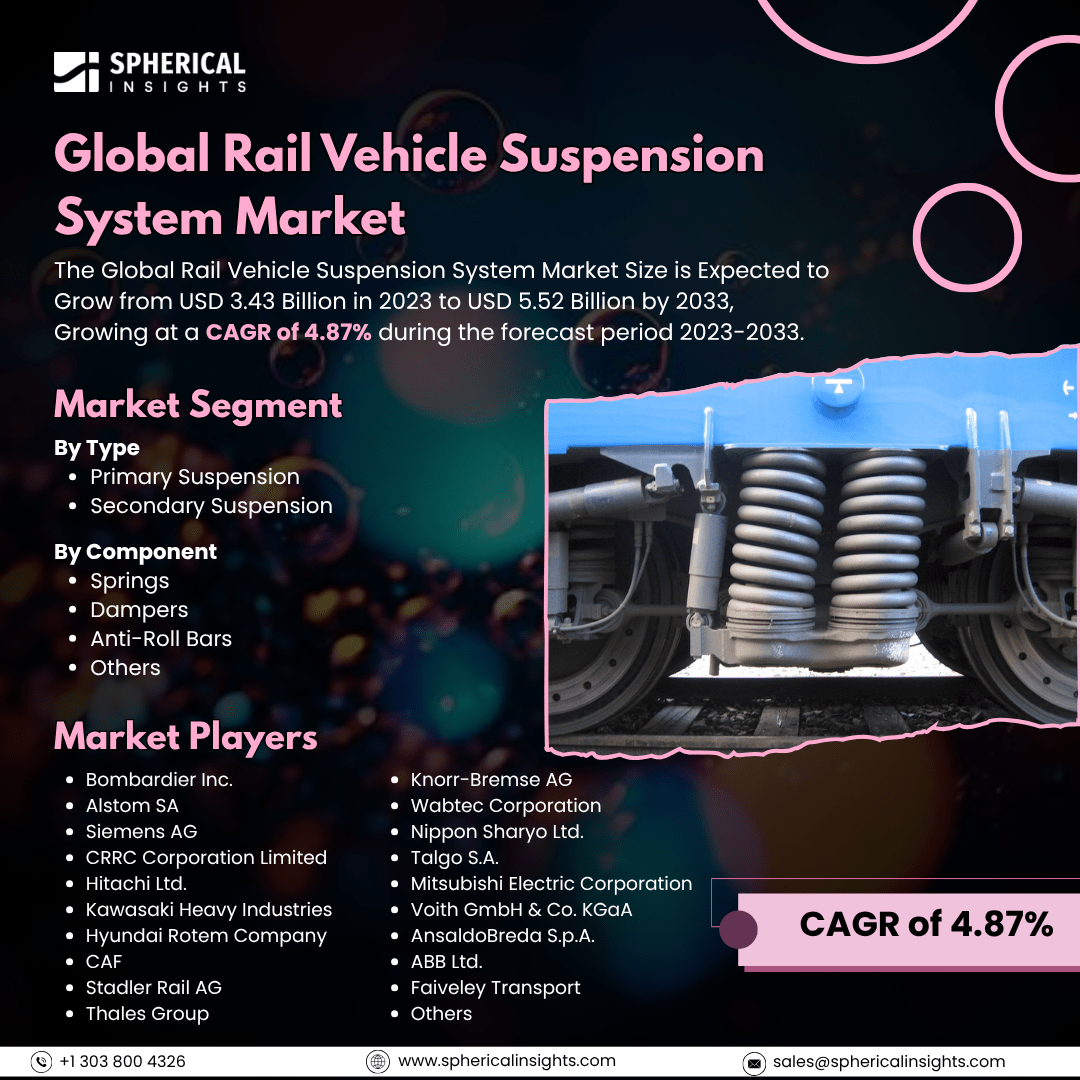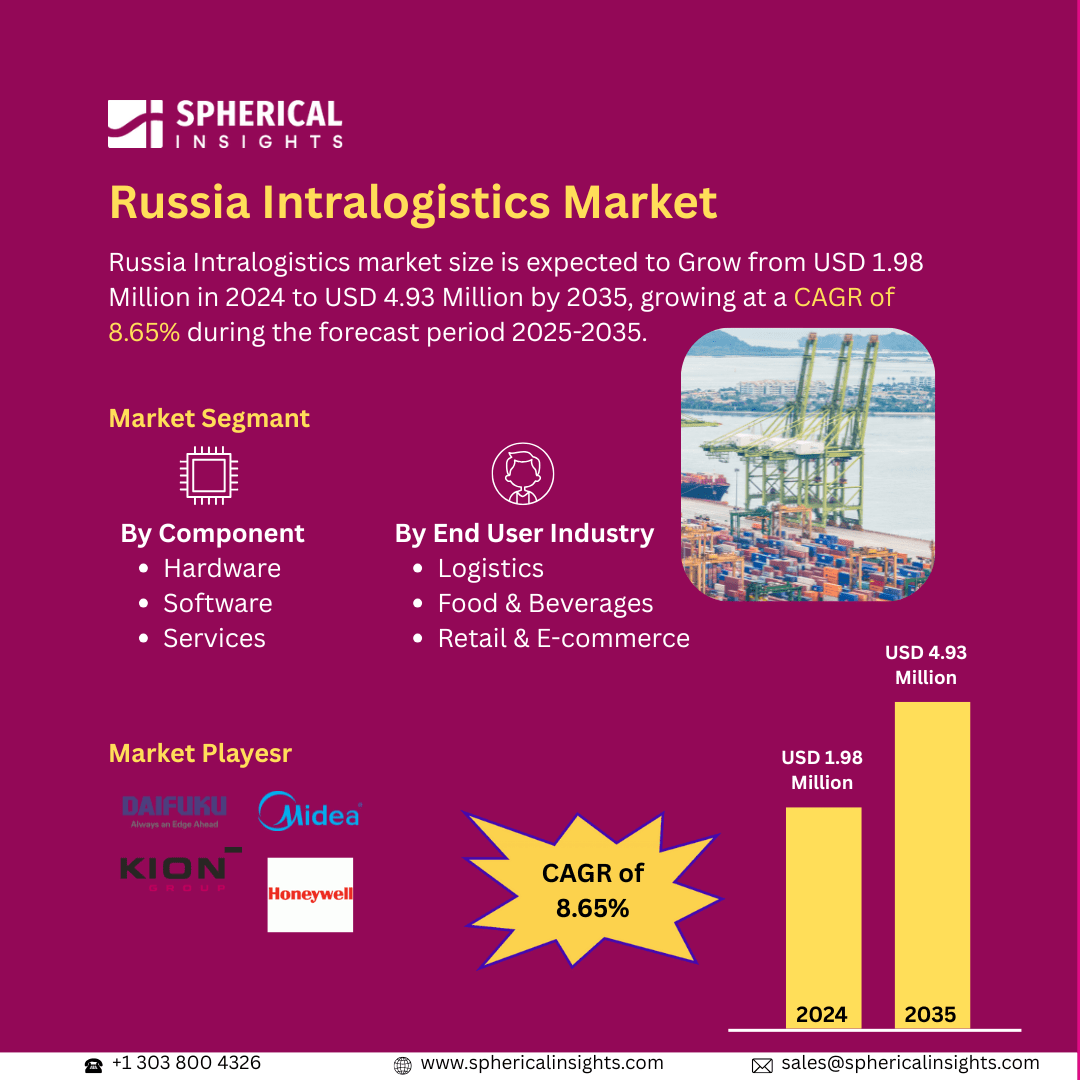Global Rail Vehicle Suspension System Market Size to Exceed USD 5.52 Billion By 2033
According to a research report published by Spherical Insights & Consulting, The Global Rail Vehicle Suspension System Market Size is Expected to Grow from USD 3.43 Billion in 2023 to USD 5.52 Billion by 2033, Growing at a CAGR of 4.87% during the forecast period 2023-2033.
Browse 210 market data Tables and 45 Figures spread through 190 Pages and in-depth TOC on the Global Rail Vehicle Suspension System Market Size, Share, and COVID-19 Impact Analysis, By Type (Primary Suspension, Secondary Suspension), By Component (Springs, Dampers, Anti-Roll Bars, Others), and By Region (North America, Europe, Asia-Pacific, Latin America, Middle East, and Africa), Analysis and Forecast 2023 - 2033
The international rail vehicle suspension system market notifies the business that supports the rail industry, which fabricates and distributes a high-performance suspension system. These systems are critical components that support the weight of the train, absorb and dampen vibrations from the track, and ensure smooth and comfortable rides for passengers. The increasing preference for fast trains, the growth and improvement of railway networks, and a greater emphasis on passenger security and comfort are some of the drivers propelling the market. The market for suspension systems for rail vehicles is growing as an outcome of the increased focus on energy sustainability and efficiency in rail transportation. These developments are appealing to governments and rail operators alike because they not only promote environmental sustainability but also result in financial savings. However, market acquisition faces several obstacles, such as lack of skilled personnel, which result in critical fatalities and high costs for upkeep.
The secondary suspension segment held a significant share of the global rail vehicle suspension system market in 2023 and is projected to grow at a rapid pace over the forecast period.
On the basis of type, the global rail vehicle suspension system market is divided into primary suspension and secondary suspension. Among these, the secondary suspension segment held a significant share of the global rail vehicle suspension system market in 2023 and is projected to grow at a rapid pace over the forecast period. This is due to the reduction of low-frequency vibrations and improved ride comfort; these systems usually include hydraulic dampers and air springs. Further, segment expansion is growing due to the need for proficient secondary suspension systems, which will be driven by the increasing focus on passenger security and comfort, especially on high-speed and metro trains.
The springs accounted for the greatest share of the global rail vehicle suspension system market in 2023 and is projected to grow at a substantial CAGR during the forecast period.
On the basis of the component, the global rail vehicle suspension system market is segmented into springs, dampers, anti-roll bars, and others. Among these, the springs segment accounted for the greatest share of the global rail vehicle suspension system market in 2023 and is projected to grow at a substantial CAGR during the forecast period. This segmental growth is attributed to market development because they offer the elasticity needed for absorbing vibrations and shocks generated by the track, making them an essential part of rail suspension systems. Moreover, high-strength materials like steel or composites are typically utilized for producing them to guarantee dependability and longevity under a variety of different circumstances to boost the segments.
Asia Pacific is projected to hold the greatest share of the global rail vehicle suspension system market over the forecast period.
Asia Pacific is anticipated to hold the largest revenue share of the global rail vehicle suspension system market over the forecast period. The regional market for rail vehicle suspension system has flourished due to the rapid growth of railroads in countries like China, India, and Japan is responsible for this domination. Further, the requirement for sophisticated suspension systems and substantial investments in high-speed rail projects and metro system extensions boost the market growth. Likewise, government initiatives and rising urbanization excel the Asia Pacific market's growth.
Europe is predicted to grow at the fastest CAGR growth of the global rail vehicle suspension system market over the forecast period. The market's expansion throughout the region is further accelerated due to being well-known for its large metro systems and high-speed rail network with leading rail technology nations like Germany, France, and the UK creating a need for creative suspension systems. Additionally, strict safety and environmental requirements that demand the use of cutting-edge and environmentally friendly suspension technologies have an impact on the regional market.
Company Profiling
Major vendors in the global rail vehicle suspension system market are Bombardier Inc., Alstom SA, Siemens AG, CRRC Corporation Limited, Hitachi Ltd., Kawasaki Heavy Industries Ltd., Hyundai Rotem Company, CAF (Construcciones y Auxiliar de Ferrocarriles), Stadler Rail AG, Thales Group, Knorr-Bremse AG, Wabtec Corporation, Nippon Sharyo Ltd., Talgo S.A., Mitsubishi Electric Corporation, Voith GmbH & Co. KGaA, AnsaldoBreda S.p.A., ABB Ltd., Faiveley Transport, and others.
Key Target Audience
- Market Players
- Investors
- End-users
- Government Authorities
- Consulting And Research Firm
- Venture capitalists
- Value-Added Resellers (VARs)
Market Segment
This study forecasts revenue at global, regional, and country levels from 2023 to 2033. Spherical Insights has segmented the global rail vehicle suspension system market based on the below-mentioned segments:
Global Rail Vehicle Suspension System Market, By Type
- Primary Suspension
- Secondary Suspension
Global Rail Vehicle Suspension System Market, By Component
- Springs
- Dampers
- Anti-Roll Bars
- Others
Global Rail Vehicle Suspension System Market, By Regional
- North America
- Europe
- Germany
- UK
- France
- Italy
- Spain
- Russia
- Rest of Europe
- Asia Pacific
- China
- Japan
- India
- South Korea
- Australia
- Rest of Asia Pacific
- South America
- Brazil
- Argentina
- Rest of South America
- Middle East & Africa
- UAE
- Saudi Arabia
- Qatar
- South Africa
- Rest of the Middle East & Africa



